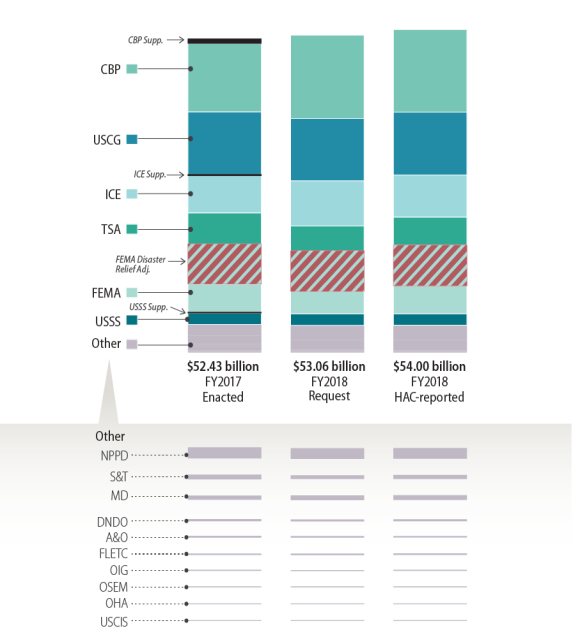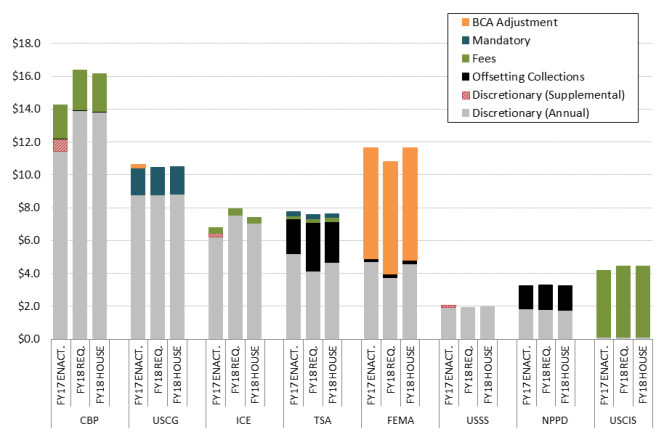Generally, the homeland security appropriations bill includes all annual appropriations for the Department of Homeland Security (DHS), providing resources to every departmental component.1 The following figures show two perspectives on the budget authority for DHS enacted for FY20172 and requested by the Donald Trump Administration for FY2018, as well as the funding levels provided in H.R. 3355, the House committee-reported homeland security appropriations bill.
Figure 1 shows total net discretionary appropriations for DHS divided by departmental component, and ordered from largest to smallest by FY2017 enacted annual funding level.
In Figure 1, the first column shows (by component) the budget authority provided in P.L. 115-31, which included the FY2017 annual appropriations act for DHS as the first five titles of Division F, and supplemental appropriations for DHS as the sixth. Supplemental funding is shown in black to distinguish it from annual appropriations. Appropriations with the disaster relief designation are shown with a pattern to distinguish them from net discretionary appropriations. The second column shows a similar breakdown by component for the FY2018 request, while the third shows the House Appropriations Committee-reported proposed funding levels as outlined in H.R. 3355 and H.Rept. 115-239.
|
Figure 1. Department of Homeland Security Net Discretionary Budget Authority and Disaster Relief by Component, FY2017-FY2018 (billions of dollars; supplemental funding in black, disaster relief patterned) |
 |
|
Source: CRS analysis of H.Rept. 115-239. Note: For underlying data and notes on data, see Table 1. Abbreviations: CBP, Customs and Border Protection; USCG, U.S. Coast Guard; ICE, Immigration and Customs Enforcement; TSA, Transportation Security Administration; FEMA, Federal Emergency Management Agency; USSS, U.S. Secret Service; NPPD, National Protection and Programs Directorate; S&T, Science and Technology Directorate; MD, Management Directorate; DNDO, Domestic Nuclear Detection Office; A&O, Analysis and Operations; FLETC, Federal Law Enforcement Training Center; OIG, Office of the Inspector General; OSEM, Office of the Secretary and Executive Management; OHA, Office of Health Affairs; USCIS, U.S. Citizenship and Immigration Services. |
While the total net discretionary budget authority, when adjusted for the effect of rescissions, provides the "score" that is measured against the bill's discretionary spending allocation, it does not represent the total budget authority provided to DHS. "Net" discretionary appropriations are the net balance of discretionary appropriations minus any offsetting collections. Such collections are addressed in the appropriations legislation, and provide significant resources to some components of DHS, such as the Transportation Security Administration and National Protection and Programs Directorate. They do not include mandatory spending, resources derived directly from fee collections without annual congressional action, or resources covered by adjustments to the discretionary spending limits.3 Congress controls the reprogramming of these resources through detailed tables provided in appropriations committee reports, conference reports, and statements of managers.
Figure 2 uses the data drawn from these detailed tables to show a more complete picture of the resources available to eight DHS components: U.S. Customs and Border Protection, the U.S. Coast Guard, Immigration and Customs Enforcement, the Transportation Security Administration, Federal Emergency Management Agency, U.S. Secret Service, and U.S. Citizenship and Immigration Services—the seven operational components—and the National Protection and Programs Directorate.
In Figure 2, these eight components are listed along the bottom axis. Each component's funding level as a section of the figure has three bars, representing the same three phases of the appropriations process as in Figure 1: funding described in the explanatory statement accompanying the enacted FY2017 appropriations for DHS; requested by the Trump Administration for FY2018; and recommended by the House Appropriations Committee for FY2018 in H.Rept. 115-239. The bottom segment of each bar represents net discretionary budget authority—the same amount for each as represented in Figure 1. As in Figure 1, supplemental appropriations (which would be included in calculations of both net and total discretionary budget authority in the act) are reflected separately from annual appropriations.
On top of these segments are several other types of segments, representing fee revenues, offsetting collections, mandatory spending,4 and funding covered by adjustments to discretionary spending limits under the Budget Control Act of 2011 (BCA; P.L. 112-25).5 The resulting diagram allows for easier comparison of changes in individual component appropriations, and provides a more accurate description of each component's overall resource level. Among the changes it illuminates are the increase in CBP's budget for proposed border barrier funding, partial acceptance of increases in ICE operations funding by the House Appropriations Committee, an increase in discretionary spending to support the TSA's budget in the absence of the Trump Administration's proposed fee increase, and House Appropriations Committee rejection of proposed cuts in FEMA's grant programs.
|
Figure 2. Department of Homeland Security Budget Authority by Selected DHS Component, FY2017-FY2018 (billions of dollars of budget authority controlled for reprogramming through appropriations committee reports) |
 |
|
Source: CRS analysis of H.Rept. 115-239. Note: For underlying data and notes on data, see Table 1. "FY2018 House" column reflects the position in the Appropriations Committee-reported bill. Abbreviations: CBP, Customs and Border Protection; USCG, U.S. Coast Guard; ICE, Immigration and Customs Enforcement; TSA, Transportation Security Administration; FEMA, Federal Emergency Management Agency; USSS, U.S. Secret Service; NPPD, National Protection and Programs Directorate; USCIS, U.S. Citizenship and Immigration Services. |
Table 1 provides a complete breakdown of the net discretionary budget authority outlined in Figure 1 and the five aspects of funding outlined in Figure 2 for all DHS components.
Table 1. Department of Homeland Security Budget Authority by DHS Component, FY2017-FY2018
(thousands of dollars of budget authority controlled for reprogramming through appropriations committee reports)
|
Component / Funding Aspect |
FY2017 Enacted |
FY2018 Request |
House Committee Reported H.R. 3355 |
|
Customs and Border Protection |
14,280,721 |
16,403,729 |
16,152,703 |
|
Net Discretionary |
12,168,881 |
13,907,061 |
13,813,035 |
|
Annual |
11,414,668 |
13,907,061 |
13,813,035 |
|
Supplemental |
772,213 |
0 |
0 |
|
Offsetting Collections |
39,000 |
39,000 |
39,000 |
|
Fees |
2,054,840 |
2,457,668 |
2,300,668 |
|
U.S. Coast Guard |
10,617,203 |
10,441,258 |
10,486,258 |
|
Net Discretionary |
8,787,571 |
8,768,258 |
8,813,258 |
|
Mandatory |
1,666,940 |
1,673,000 |
1,673,000 |
|
Budget Control Act Adjustment |
162,692 |
— |
— |
|
Immigration and Customs Enforcement |
6,796,240 |
7,942,072 |
7,431,552 |
|
Net Discretionary |
6,435,240 |
7,565,462 |
7,054,942 |
|
Annual |
6,198,332 |
7,565,462 |
7,054,942 |
|
Supplemental |
236,908 |
— |
— |
|
Fees |
361,000 |
376,610 |
376,610 |
|
Transportation Security Administration |
7,771,340 |
7,582,228 |
7,646,937 |
|
Net Discretionary |
5,186,140 |
4,121,669 |
4,686,378 |
|
Offsetting Collections |
2,130,000 |
2,970,000 |
2,470,000 |
|
Fees |
205,200 |
240,559 |
240,559 |
|
Mandatory |
250,000 |
250,000 |
250,000 |
|
Federal Emergency Management Agency |
11,618,331 |
10,773,070 |
11,637,707 |
|
Net Discretionary |
4,723,532 |
3,726,570 |
4,591,207 |
|
Offsetting Collections |
181,799 |
253,500 |
253,500 |
|
Budget Control Act Adjustment |
6,713,000 |
6,793,000 |
6,793,000 |
|
U.S. Secret Service |
2,045,578 |
1,943,626 |
1,957,495 |
|
Net Discretionary |
2,045,578 |
1,943,626 |
1,957,495 |
|
Annual |
1,914,578 |
1,943,626 |
1,957,495 |
|
Supplemental |
131,000 |
— |
— |
|
National Protection and Programs Directorate |
3,269,850 |
3,277,489 |
3,249,276 |
|
Net Discretionary |
1,818,772 |
1,801,434 |
1,773,221 |
|
Offsetting Collections |
1,451,078 |
1,476,055 |
1,476,055 |
|
Science and Technology Directorate |
781,746 |
627,324 |
638,100 |
|
Net Discretionary |
781,746 |
627,324 |
638,100 |
|
Management Directorate |
673,624 |
768,664 |
768,664 |
|
Net Discretionary |
673,624 |
768,664 |
768,664 |
|
Domestic Nuclear Detection Office |
352,484 |
330,440 |
330,440 |
|
Net Discretionary |
352,484 |
330,440 |
330,440 |
|
Analysis and Operations |
263,551 |
252,405 |
252,405 |
|
Net Discretionary |
263,551 |
252,405 |
252,405 |
|
Federal Law Enforcement Training Center |
242,518 |
272,759 |
260,099 |
|
Net Discretionary |
242,518 |
272,759 |
260,099 |
|
Office of the Inspector General |
175,000 |
133,974 |
154,830 |
|
Net Discretionary |
175,000 |
133,974 |
154,830 |
|
Office of the Secretary and Executive Management |
137,034 |
130,307 |
140,997 |
|
Net Discretionary |
137,034 |
130,307 |
140,997 |
|
Office of Health Affairs |
123,548 |
111,319 |
119,319 |
|
Net Discretionary |
123,548 |
111,319 |
119,319 |
|
U.S. Citizenship and Immigration Services |
4,181,364 |
4,442,039 |
4,442,039 |
|
Net Discretionary |
121,139 |
131,513 |
131,513 |
|
Fees |
4,060,225 |
4,310,526 |
4,310,526 |
|
TOTAL NET DISCRETIONARY BUDGET AUTHORITY PLUS DISASTER RELIEF, DHS |
52,434,298 |
53,058,785 |
54,001,903 |
Sources: CRS analysis of Division F of P.L. 115-31 and its explanatory statement as printed in the Congressional Record of May 3, 2017, pp. H3807-H3873, and H.Rept. 115-239.
Note: Totals do not reflect the impact of rescissions.
These five aspects of funding controlled for reprogramming through the appropriations reports do not reflect all funding available to these components. Much of DHS's mandatory spending, including spending on flood insurance claims, as well as trust funds for the Coast Guard and the Secret Service, is not reflected in the detailed appropriations committee-generated tables that control reprogrammings.